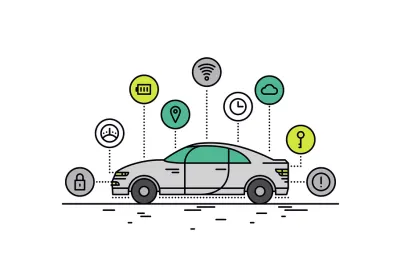Market Intelligence
The pace of innovation in the electric, autonomous, and connected vehicle space is staggering. These innovations relate to advanced sensors, radar and LiDAR, geolocation, artificial intelligence algorithms, telecommunications, and the software used to integrate all these components and collect and process the data to enable new or improved vehicular functionality. Supported by copious investments from around the world, companies are racing to bring these new technologies to market ahead of their competitors. To protect against late entrants adopting their technology and allow investors to hedge their risk, companies use patents to create barriers to entry, generate revenue streams, or otherwise provide leverage, filing 25K+ such patents in 2018. (Patent Trends Study Part Five: Automotive Industry)
However, not all innovations may be eligible for patent protection. As discussed in the 2014 Supreme Court case Alice Corp. v. CLS Bank International, 573 U.S. 208 (“Alice”), inventions that are directed to abstract ideas or mathematical algorithms, so called “judicial exceptions,” may be ineligible for receiving patent protection. This may impact certain software implemented inventions related to artificial intelligence (“AI”) or Internet of Vehicles (“IoV”) technologies, and may even discourage companies from pursuing patent protection for such inventions. For example, since 2014, the number of patent applications filed annually for AI inventions in Digital Marketing, FinTech, Education, and Entertainment actually declined significantly. (Industry-Focused Patenting Trends, page 16.)
While the patent eligibility framework established by the Supreme Court in Alice left much uncertainty about what exactly is eligible for patent protection, subsequent opinions issued by the U.S. Court of Appeals for the Federal Circuit (“CAFC”) provide a roadmap for patent eligibility. The CAFC stated that
"[s]oftware can make non-abstract improvements to computer technology just as hardware improvements can.” (Enfish, LLC v. Microsoft Corp., 822 F.3d 1327 (Fed. Cir. 2016). The CAFC further emphasized in MCRO, Inc. v. Bandai Namco Games America, decided September 13, 2016, (“MCRO”) that inventions may be eligible for patenting when “it is the incorporation of... claimed rules, not the use of the computer, that improve the existing technological process by allowing the automation of further tasks.” The U.S. Patent and Trademark Office recently provided new guidance stating that a claim directed to a practical application of a judicial exception, such as providing an improvement to the functioning of a computer or another technology, is eligible for patent protection. (Revised Patent Subject Matter Eligibility Guidance issued by the U.S. Patent and Trademark Office on January 7, 2019)
Most vehicular AI or IoV inventions likely provide an improvement to computer technology, an improvement to an existing technological process, or a practical application that improves the functioning of a computer or other technology and may, therefore be eligible for patent protection. However, patents may not be used to protect data compilations, such as AI training sets, or a programmer’s particular expression of source code. Even if the AI or IoV invention is eligible for patent protection, it can be challenging to accurately and precisely describe the methods or functions of an iterative/incremental machine learning process in a manner that satisfies the patent law requirements and also has a sufficiently broad scope of protection that companies can leverage for business purposes. As such, certain under-the-hood aspects of an AI or IoV innovation may be kept as a trade secret or protected via copyright, while other front-facing or easily reverse-engineerable aspects may be patented.
Congress has not stayed silent either. A new bipartisan bill impacting patent eligibility was proposed on May 22, 2019 that aims to remove the judicial exceptions and many of the various tests created by the Supreme Court and the CAFC. The proposed bill includes text explicitly abrogating or rendering invalid past case law interpreting exceptions to patenting eligibility. The bill has not been finalized, and the Senate Judiciary IP Subcommittee held hearings in early June to discuss the impact of the proposed legislation and potential changes.
To continue building valuable intellectual property assets as was done for vehicular hardware or manufacturing processes, companies will revise their IP strategies based on recent patent case law and in view of the proposed changes to the patent statutes to determine how to protect software-based inventions that enable new or improved IoV functionality or other vehicular functionality using AI.
Trends in IT Licensing for the Auto Industry
In the not-so-distant past, the automotive industry sought to be mostly self-sufficient. That is to say, that when an automobile manufacturer (commonly referred to as an OEM) wished to add a new feature to one of its vehicles, it developed that feature itself, with little to no help from outside sources. Today, such an approach is neither practical nor cost-efficient. Technology in vehicles is evolving at a rate OEMs are ill-equipped to handle. Customer demand for increased interoperability and functionality, including cars offering digital services ranging from entertainment to maintenance, is pushing OEMs to seek solutions outside of their traditional routes.
Although an OEM may not necessarily own the intellectual property for a car’s new smart features, licensing technology does present opportunities for OEMs to lower costs, as they do not have to invest in intellectual property development and enforcement. However, increased licensing also poses unique legal risks. In particular, licensing agreements should carefully consider exclusivity of any licensed feature, ownership of any custom modifications to the licensed feature, and ownership of the data derived from the driver’s use of a vehicle with such a feature. Special attention should also be given to developing strong confidentiality and ownership protections of the OEM’s technology assets, including any OEM-unique specifications or modifications to the licensed technology. Often, smart technology increases the amount of driver personal information collected by the car and accordingly by the OEM, so strong data protection and security language is a must to reduce the risk of a security breach, or a breach of applicable privacy laws. In sum, whether you are an OEM or a technology service provider, the structure of your licensing agreement, and the clauses protecting your intellectual property, will become increasingly important in an increasingly digital age.
Commercial and Development Agreements
The standard terms and conditions utilized in the automotive industry by original equipment manufacturers and most large tier suppliers grant generous intellectual property rights and uses to the buyers of developed technology or products incorporating such technology, as well as in the “background” technology used in the application or enhancement that is the subject of the development work. Thus, it is important that suppliers consider entering in to negotiated and detailed development and commercial agreements that address the responsibilities and obligations of the development work and the permitted uses of the technology, including any background technology, as well as things like pricing, testing, and warranty obligations related to the use of such technology. Keep in mind that the standard terms and conditions typically used in the automotive industry also contain broad warranty, recall, and indemnification provisions that include general warranties of fitness and design. Such terms may not be appropriate in certain circumstances and may require review and possible modification, depending on whom has assumed what responsibilities in connection with the selection, testing, and integration of the technology. In summary, it is important to analyze and determine whether the relationship requires a customized agreement to address the rights and obligations arising from the collaboration, especially in light of the standard terms of the buyer, which may apply absent such an agreement.
Recent Legal Developments
Supreme Court Rules on Rejection of Executory Contracts by a Chapter 11 Debtor
In May, the Supreme Court held in Mission Product Holdings, Inc. v. Tempnology, LLC that the rejection of an executory contract under Section 365 of the Bankruptcy Code “breaches a contract but does not rescind it. And that means all the rights that would ordinarily survive a contract breach ... remain in place.” While the holding of Mission Product Holdings applies to all executory contracts - “meaning a contract that neither party has finished performing” - the facts of the case were the rejection of a trademark license by the debtor-licensor. This case had been closely monitored in part because trademarks are not included in the definition of intellectual property under the Bankruptcy Code and therefore are not explicitly covered by the intellectual property license provisions of Section 365(n).
Justice Sotomayor concurred in the Court’s decision in part to make clear that “the Court does not decide that every trademark licensee has the unfettered right to continue using licensed marks post rejection.” Rather, the rejection of the trademark license acts as a breach of that contract leaving the contract subject to “the special terms in [the] licensing contract or state law” that apply to the license following a breach. This means that a licensee seeking to ‘bankruptcy-proof’ a trademark license will want to take care to have the right to use the licensed marks survive a licensor’s breach due to a rejection of the contract under Section 365 of the Bankruptcy Code.








 />i
/>i

